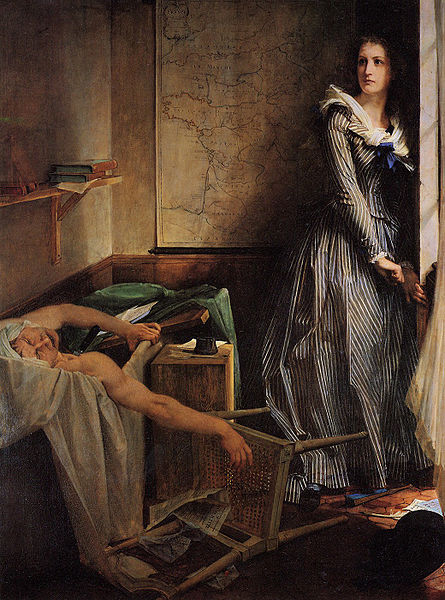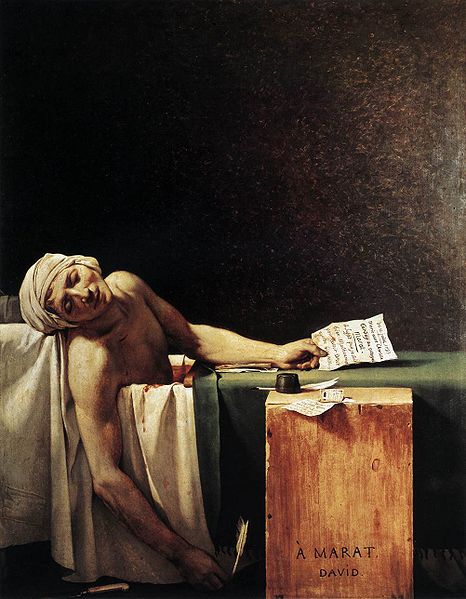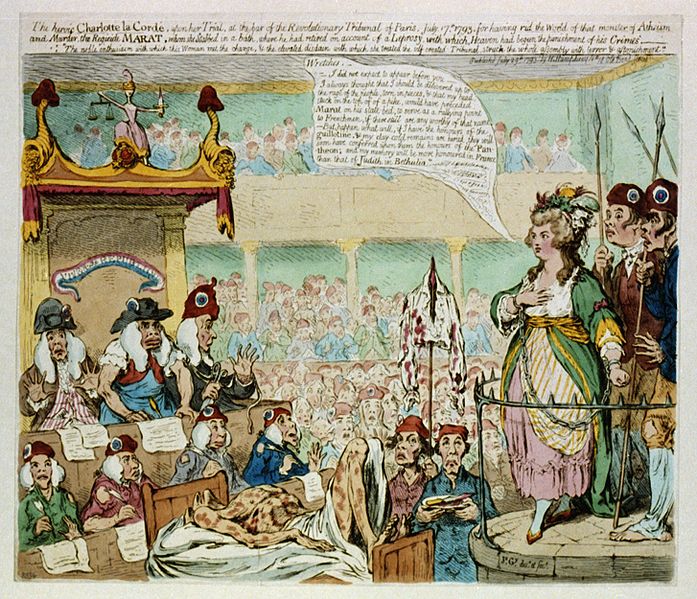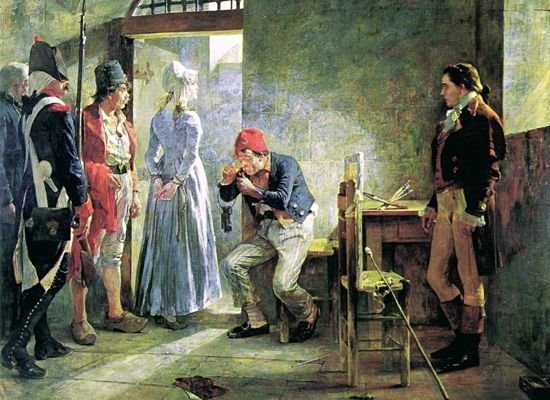<Back to Index>
- Astronomer George Biddell Airy, 1801
- Writer Vladimir Galaktionovich Korolenko, 1853
- French Revolutionary Marie Anne Charlotte de Corday d'Armont, 1768
PAGE SPONSOR


Marie-Anne Charlotte de Corday d'Armont (27 July 1768 – 17 July 1793), known to history as Charlotte Corday, was a figure of the French Revolution. In 1793, she was executed under the guillotine for the assassination of Jacobin leader Jean - Paul Marat, who was partly responsible for the Reign of Terror. His murder was memorialized in a celebrated painting by Jacques - Louis David which shows Marat after Corday had stabbed him to death in his bathtub. In 1847, writer Alphonse de Lamartine gave Corday the posthumous nickname l'ange de l'assassinat (the Angel of Assassination).
Born in Saint-Saturnin-des-Ligneries, a hamlet in the commune of Écorches (Orne), in Normandy, France, Charlotte Corday was a member of a minor aristocratic family. She was a fifth generation matrilineal descendant of the dramatist Pierre Corneille. Her parents were cousins. While
Corday was a young girl, her mother, Charlotte Marie Jacqueline
Gaultier de Mesnival (1737 – 1782) and her older sister died. Her father,
Jacques François de Corday, seigneur d'Armont (1737 – 1798), unable to cope with his grief over their death, sent Charlotte and her younger sister to the Abbaye-aux-Dames convent in Caen where she had access to the abbey's library and first encountered the writings of Plutarch, Rousseau and Voltaire. After
1791, she lived in Caen with her cousin, Madame Le Coustellier de
Bretteville-Gouville. The two developed a close relationship and Corday
was the sole heir to her cousin's estate. Jean-Paul Marat was a member of the radical Jacobin faction which would have a leading role during the Reign of Terror. As a journalist, he exerted power and influence through his newspaper, L'Ami du peuple ("The Friend of the People"). Corday's decision to kill Marat was stimulated not only by her revulsion at the September Massacres, for which she held Marat responsible, but for her fear of an all out civil war. She
believed that Marat was threatening the Republic, and that his death
would end violence throughout the nation. She also believed that King Louis XVI should not have been executed. On 9 July 1793, Corday left her cousin, carrying a copy of Plutarch's Parallel Lives, and went to Paris, where she took a room at the Hôtel de Providence. She bought a kitchen knife with a six-inch blade. She then wrote her Addresse aux Français amis des lois et de la paix ("Address to the French people, friends of Law and Peace") to explain her motives for assassinating Marat. She went first to the National Assembly to
carry out her plan, but discovered Marat no longer attended meetings.
She went to Marat's home before noon on 13 July, claiming to have
knowledge of a planned Girondist uprising in Caen; she was turned away. On her return that evening, Marat admitted her. At the time, he conducted most of his affairs from a bathtub because of a debilitating skin condition.
Marat wrote down the names of the Girondists that she gave to him, then
she pulled out the knife and plunged it into his chest, piercing his lung, aorta and left ventricle. He called out, Aidez-moi, ma chère amie! ("Help me, my dear friend!") and died. This is the moment memorialised by Jacques-Louis David's painting. The iconic pose of Marat dead in his bath has been reviewed from a different angle in Baudry's
posthumous painting of 1860, both literally and interpretively: Marat,
rather than Corday, has been made the hero of the action. At
her trial, Corday testified that she had carried out the assassination
alone, saying "I killed one man to save 100,000." It was likely a
reference to Maximilien Robespierre's words before the execution of King Louis XVI. On 17 July 1793, four days after Marat was killed, Corday was executed under the guillotine and her corpse was disposed of in the Madeleine Cemetery. After her decapitation, a man named Legros lifted her head from the basket and slapped it on the cheek. Witnesses
report an expression of "unequivocal indignation" on her face when her
cheek was slapped. This slap was considered unacceptable and Legros was
imprisoned for three months because of his outburst. Jacobin leaders had her body autopsied immediately after her death to see if she was a virgin. They believed there was a man sharing her bed and the assassination plans. To their dismay, she was found to be virgo intacta (a virgin),
a condition that focused more attention on women throughout
France — laundresses, housewives, domestic servants — who were also rising
up against authority after having been controlled by men for so long. The assassination did not stop the Jacobins or the Terror: Marat became a martyr, and busts of him replaced crucifixes and religious statues that had been banished under the new regime.
Soon
after her death, controversy arose surrounding the color of Corday's
hair. Although her passport, filled out and signed by a Caen official,
described her hair as chestnut brown, the painting "The Murder of
Marat" byJean - Jacques Hauer portrays
Corday with powdered blonde hair. Following Corday's execution and the
popularity of Hauer's painting, stories quickly spread about how Corday
had hired a local coiffeur to straighten and lighten her hair. Although this story rapidly became popular in Paris at the time,
there is no historical evidence to support that it actually happened.
Part of the reason for the discrepancy in descriptions of Corday can be
attributed to the stigma attached to powdered hair. At the time, only
nobility and royalty ever powdered their hair, and in that time of
violent anti-royalist revolt, such an association could be powerful in
influencing popular opinion.

